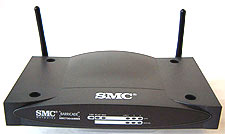Beginners Guides: Wireless home networking
Getting started with wireless? We have info you can't afford to miss - Version 1.2.0
As everyone
knows, Wireless networking is hot. Or at least the idea of it is...
Wireless networks abound in coffee franchises, Colleges and even McDonalds (in
theory). And why not? It's an inherently desirable idea. No wires, minimal
setup, as we said, why not ?
Well, price used to be the reason, but now driving
this boom is the falling price of basic wireless networking equipment. The
premium over conventional wired networks has dropped to a point where wireless
is a valid option for most home networks, not just businesses and educational
institutions. So let's look into what is involved in making your home network
wireless.
This article will cover purchasing and setting up
home wireless equipment, look at the available standards for wireless
networking, and cover some basic security guidelines. If you have already set up
a conventional home network, jump right in. Otherwise you may wish to read the PCSTATS Guide to basic home networking to get a better idea of the basics of
networking computers.
This article assumes a few things: That you have two or
more computers with Windows operating systems, a basic knowledge of computer
terms, and an understanding of what networking computers together
implies.
To get your wireless network
off the ground, you will need:
1. A wireless router (an
access-point can be used instead, but for a home network, purchasing a wireless
router is recommended for the added bonus of Internet sharing and security.
Also, home wireless routers tend to be cheaper than access points, since the
latter are primarily marketed to businesses.)
 |
| This SMC wireless router is an
example of what could be used. Some wireless routers only have one
antenna, but we find two preferable. You can read PCSTATS' review of this
equipment here. |
2. One wireless network adaptor
for each computer or device that you wish to connect to the router/access
point.
When it comes to purchasing for your wireless
networking equipment, it pays to shop around. The majority of wireless equipment
is produced by well-known companies, such as DLink, Cisco, SMC or others and
available only as a retail box item with a retail warranty.
Generally this would mean that the best place to
purchase would be at a major electronics retailer, but since wireless networking
has become so popular, even the smaller independent computer stores stock a
variety of wireless networking gear. These smaller stores do not expect anything
like the kind of profit margins that the large retailers do, so you'll probably
find better prices from them.
Given that most items will carry a manufacturers
warranty and not a store warranty anyhow, you can save a significant amount of
money.

